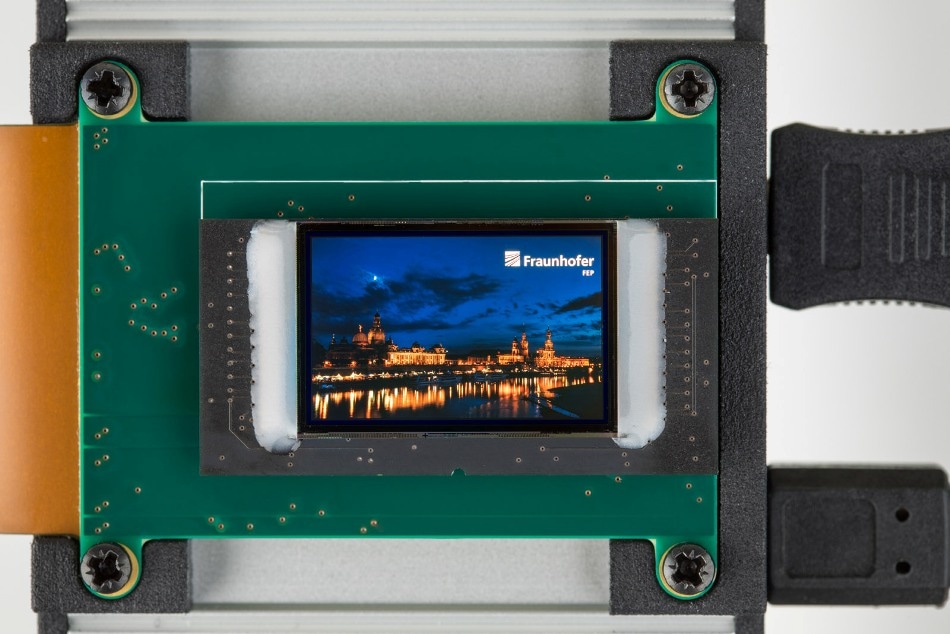Dec 4 2017
Despite being relatively popular, VR glasses are heavy and oversized – until now. Large-area microdisplays are predicted to change all that, as they make it viable to create VR glasses that are both ergonomic and lightweight. The latest OLED displays are now capable of reaching very high frame rates and achieving very high resolutions with “extended full HD”.
 Thanks to a cleverly designed system concept and modern design methodology, the new OLED microdisplay achieves a resolution of 1920 x 1200 pixels. (© Claudia Jacquemin)
Thanks to a cleverly designed system concept and modern design methodology, the new OLED microdisplay achieves a resolution of 1920 x 1200 pixels. (© Claudia Jacquemin)
The result is a crystal clear image, making individuals feel as if they are actually walking through the remarkable worlds that are conjured up around them by their VR glasses. However, until now, the VR glasses have traditionally been quite bulky and heavy and that was mainly attributed to the display, which happens to be the major component in each pair of VR glasses. VR glasses that are commercially available in the market employ displays that are developed for the smartphone market. Such displays use simple optics to give a wide field of view and are cheaply available.
However, one drawback is that they create pixelated images because of their insufficient pixel density and limited resolution. Also used are modulating LCD and LCOS microdisplays, but these are not self-illuminating, that is, they require an external light source. In an effort to create light and ergonomic VR glasses, some manufacturers are already concentrating on OLED microdisplays.
These displays are based on organic light-emitting diodes, which are self-illuminating and built into a silicon chip. Therefore, they are not only energy-efficient but also yield extremely high contrast ratios >10 000:1. Moreover, the OLED microdisplays do not require a backlight, which means they can be built in a simpler fashion, without using any large number of optical components.
The fast switching speed of OLEDs is another benefit which is about a few microseconds when compared to milliseconds in the case of LCDs. This allows for high frame rates, helps acquire high frame rates, as well as to use unique modulation processes to enhance the perceived image.
Compact design and high resolution
In collaboration with partners from industry, scientists at the Fraunhofer Institute for Organic Electronics, Electron Beam and Plasma Technology FEP in Dresden are aiming to develop novel OLED microdisplays that considerably do better than other counterparts that are presently available on the market. This work is part of the EU’s LOMID project – an acronym for large cost-effective OLED microdisplays and their applications. Within LOMID project, Fraunhofer FEP is responsible for developing the built-in circuit on the silicon chip, producing OLED proto-types, and coordinating the entire project.
Our goal is to develop a new generation of OLED displays that provide outstanding picture quality and make it possible to produce VR glasses and an eyewear-based support for vision-impaired in a compact format. We aim to achieve that by means of a specially designed OLED microdisplay.
Philipp Wartenberg, Head of Department, Fraunhofer FEP
So far, so good, but what is so unique about the microdisplays that are being designed within the LOMID project? Their resolution is one answer: microdisplays are capable of achieving extended full HD, meaning they have 1920 x 1200 pixel (WUXGA) resolution. The size of the diagonal screen is approximately one inch, and the frame rate measures about 120 Hertz. That means, every second 120 images are displayed, making movements in the virtual world appear fluid.
Specially designed circuits on the chip
The microdisplay contains two components – an OLED and a silicon chip to control the pixels. Several organic layers included in this OLED are monolithically incorporated on silicon wafers. The frame rate and resolution of the microdisplay are set by the chip by means of its integrated circuit, but the type of circuit used is actually the innovative feature.
The trick isn’t just to raise the resolution and frame rate, but also to keep power consumption to a minimum at the same time. We’ve been very successful at that thanks to a cleverly designed system concept and modern design methodology, not to mention our more than ten years of experience at Fraunhofer FEP in designing and technologically implementing OLED microdisplays.
Philipp Wartenberg, Head of Department, Fraunhofer FEP
The research team has already developed its first prototype, which will be presented in Brussels from December 5th to 7th at the European Forum for Electronic Components and Systems 2017 (EFECS). By the middle of 2018, more prototypes will be developed. Industry partners who are involved in the project have already expressed their interest in changing this microdisplay into a marketable product in the coming days.
In this context, the application of OLED microdisplays is definitely not restricted to VR glasses – although this could well be the largest market in the mid-term. In addition, OLED microdisplays are suitable for other products such as view finders in cameras or augmented-reality (AR) glasses. Further, the underlying technology of CMOS-integrated light emitters (and any detectors) has promising applications in optogenetics, optical metrology and identification, and other market segments.
With respect to microdisplays in consumer-facing augmented-reality glasses, the scientists still see some challenges that need to be resolved and which they wish to address in the future. These issues include: extremely high levels of efficiency and luminance (which will require the removal of color filters that are used until now, and substituting these with directly structured emitters); curved surfaces for more compact optics; a high yield for a large (chip) area; irregular pixel arrays at even higher pixel density; circular micro-display panels; transparent substrates and integrated eye-tracking.